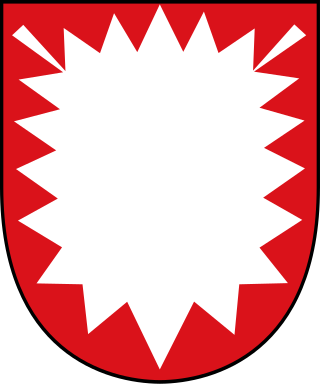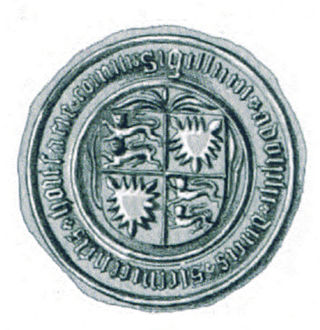Related Research Articles

Holstein is the region between the rivers Elbe and Eider. It is the southern half of Schleswig-Holstein, the northernmost state of Germany.

Adolphus XI of Schauenburg, as Adolph I Duke of Schleswig, and as Adolph VIII Count of Holstein-Rendsburg, was the mightiest vassal of the Danish realm.
The Treaty of Ribe was a proclamation at Ribe made in 1460 by King Christian I of Denmark to a number of Holsatian nobles enabling himself to become Count of Holstein and gain control of the Duchy of Schleswig. The most famous line of the proclamation was that the Danish Duchy of Schleswig and the County of Holstein within the Holy Roman Empire, should now be, in the original Middle Low German language, Up Ewig Ungedeelt, or "Forever Undivided".

Helvig of Schauenburg (1398–1436) was a duchess of Schleswig and a countess of Holstein from the family of Schauenburg. She was the mother of King Christian I of Denmark and ancestor of the Danish Royal houses of Oldenburg and Schleswig-Holstein-Sonderburg-Glücksburg.

The (second) Battle of Bornhöved took place on 22 July 1227 near Bornhöved in Holstein. Count Adolf IV of Schauenburg and Holstein — leading an army consisting of troops from the cities of Lü

The Counts of Schauenburg and Holstein were titles of the Frankish Empire. The dynastic family came from the County of Schauenburg near Rinteln on the Weser in Germany. Together with its ancestral possessions in Bückeburg and Stadthagen, the House of Schauenburg ruled the County of Schauenburg and the County of Holstein. The comital titles of Holstein were subject to the liege lord, the Dukes of undivided Saxony till 1296, and thereafter the Dukes of Saxe-Lauenburg.

The House of Schaumburg was a dynasty of German rulers. Until c. 1485, it was also known as the House of Schauenburg. Together with its ancestral possession, the County of Schaumburg, the family also ruled the County of Holstein and its partitions Holstein-Itzehoe, Holstein-Kiel, Holstein-Pinneberg, Holstein-Plön, Holstein-Segeberg and Holstein-Rendsburg and through the latter at times also the Duchy of Schleswig.

The Duchy of Holstein was the northernmost state of the Holy Roman Empire, located in the present German state of Schleswig-Holstein. It originated when King Christian I of Denmark had his County of Holstein-Rendsburg elevated to a duchy by Emperor Frederick III in 1474. Members of the Danish House of Oldenburg ruled Holstein – jointly with the Duchy of Schleswig – for its entire existence.

The County of Schaumburg, until ca. 1485 known as Schauenburg, was a state of the Holy Roman Empire, located in the present German state of Lower Saxony. Its territory was more or less congruent with the present district Landkreis Schaumburg.

Schülp bei Rendsburg is a municipality in the district of Rendsburg-Eckernförde, in Schleswig-Holstein, Germany.
Adolf IV, was a Count of Schauenburg (1225–1238) and of Holstein (1227–1238), of the House of Schaumburg. Adolf was the eldest son of Adolf III of Schauenburg and Holstein by his second wife, Adelheid of Querfurt.

Gerhard I, Count of Holstein-Itzehoe was the only count of Holstein-Itzehoe.

Henry I, Count of Holstein-Rendsburg (1258–1304) was the first Count of Holstein-Rendsburg.

Nicholas, Count of Schauenburg and Holstein-Rendsburg was a titular Count of Schauenburg. Together first with his brother and then with his nephews, Nicholas was the co-ruling Count of Holstein-Rendsburg from 1340 until his death. In 1390 Nicholas and his nephews inherited Holstein-Kiel, which itself included former Holstein-Plön through reversion in 1350. So except of Holstein-Pinneberg Nicholas and his nephews had united all of Holstein. He was also co-ruler of Schleswig from 1375 to 1386. He was thus a leading member of the House of Schauenburg and an influential figure in the area north of the Elbe. He was the second son of Count Gerhard III of Holstein-Rendsburg and his wife, Sophia of Werle.
Henry IV, Count of Holstein-Rendsburg was Count of Holstein-Rendsburg and Duke of Schleswig from 1404 until his death.

Albert II of Holstein was the ruling Count of Holstein-Rendsburg from his father's death, in 1381 or 1384, until 1397. From 1397 until his death, he was Count of Holstein-Segeberg.

Henry III, Count of Schauenburg-Holstein was Bishop of Osnabrück as Henry I from 1402 to 1410, and also Count of Holstein-Rendsburg from 1404 until his death.

Holstein-Rendsburg is the name of a county that existed from 1290 to 1459, ruled by a line of the Schauenburg family.

The County of Holstein-Pinneberg, also known as the County of Schauenburg and Holstein-Pinneberg, was a small territory which existed from 1290 until 1640, centred around Pinneberg in modern-day Schleswig-Holstein, Germany.
References
- Mathieu Olivier. 2005. Le prince et l'histoire dans le comté de Holstein, au miroir du Chronicon Holtzatiae Auctore Presbytero Bremensi. Médiévales, 48:99–122.